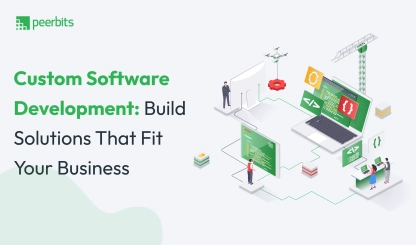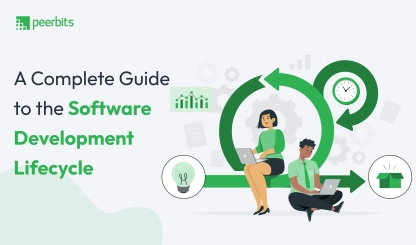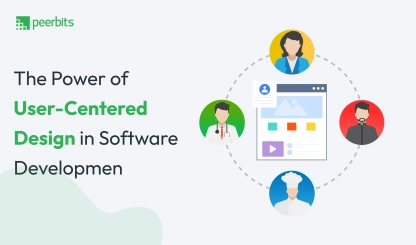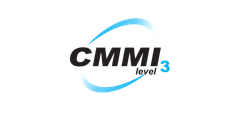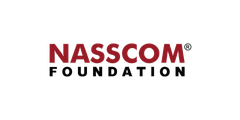Bringing a product to life involves more than just development. It requires careful planning, thoughtful design, rigorous testing, and continuous refinement to meet market demands. This is where product engineering services become indispensable.
They guide businesses through every stage of the product lifecycle, ensuring the creation of reliable and scalable solutions that deliver value to users.
For enterprises aiming to stay ahead in a competitive landscape, enterprise product engineering services are important. They tackle challenges like modernizing legacy systems, integrating complex architectures, and building scalable platforms that grow with your business.
This blog serves as a product engineering guide, offering insights into the key components and benefits of software product engineering services. Discover how these services help businesses craft solutions designed for success.
What is product engineering?
Product engineering refers to the end-to-end process of designing, developing, testing, and maintaining a product. It encompasses every phase, from conceptualizing an idea to re-engineering it for continued success.
These services focus on transforming concepts into functional solutions by combining expertise in design, technology, and market trends.
The scope of product engineering services includes a variety of activities such as building enterprise applications, integrating cutting-edge tools, modernizing outdated systems, and ensuring products remain competitive through innovation.
Importance of connecting technology with business goals
The strength of a product lies in its ability to solve real-world problems while meeting the objectives of the business behind it. Enterprise product engineering services ensure that technology is used as a strategic tool to achieve these goals.
For example:
- Businesses leveraging scalable product engineering create solutions that grow with customer demands.
- Using API in SaaS product development, companies streamline data flow between applications, enhancing functionality and user experience.
- Organizations achieve faster delivery cycles without compromising quality by employing agile methodologies.
Aligning technical development with business priorities ensures that the final product is not just technically sound but also market-ready and aligned with customer expectations.
Examples of successful product engineering in businesses
1. Netflix: The company’s adaptive video streaming platform is a result of robust software product engineering services. By continuously re-engineering its backend, Netflix delivers unmatched performance and user satisfaction.
2. Tesla: Known for its electric vehicles, Tesla’s success stems from integrating innovative technologies with practical designs for its projects.
3. Amazon Web Services (AWS): AWS uses scalable product engineering to build solutions that cater to businesses of all sizes, offering flexible and powerful cloud platforms.
These examples highlight how effective software product development services transform challenges into opportunities, creating products that redefine industries.
When should businesses adopt product engineering?
These are the signs that indicate when businesses should consider product engineering services:
- Difficulty keeping up with evolving customer expectations or market trends.
- Frequent technical glitches or inefficiencies in current software.
- Challenges in incorporating new features or integrating with other systems.
- Delayed project timelines due to outdated processes or methods.
These situations suggest the need for a structured and strategic approach to product development.
Situations where product engineering makes a difference
1. Market shifts: Sudden changes in the industry can make existing products less effective. In such cases, product engineering helps businesses create innovative solutions to adapt quickly.
2. Outdated systems: Older software can become a roadblock to progress. By using enterprise product engineering services, companies can upgrade their systems to match modern requirements and stay competitive.
3. Growth challenges: Expanding businesses often find their existing software unable to handle increased user demand. Adopting scalable product engineering ensures systems can support growing needs efficiently.
4. Customer-focused innovation: Rapidly shifting consumer needs require businesses to design solutions that cater to specific demands. Incorporating elements like API in SaaS product development adds flexibility and enhances user satisfaction.
These scenarios highlight when businesses should rethink their development strategies and adopt software product engineering services for long-term success.
Core components of product engineering services
The success of product engineering lies in its ability to address specific business needs. Key components such as custom application development, smooth software integration, and modernizing outdated systems ensure that products not only meet current requirements but are also built for future challenges.
1. Custom enterprise application development
Custom enterprise application development is about creating software solutions designed specifically to meet the unique needs of a business. These tailored solutions are built to integrate with existing processes, improve efficiency, and address the challenges faced by the organization.
For example, a business aiming to improve supply chain management might develop a custom application that automates inventory tracking, provides real-time updates, and integrates with other internal systems. This ensures the solution is perfectly suited to the business's requirements, offering greater control and better results.
2. New software integration
When businesses introduce new software, integrating it with existing systems is essential for smooth operations. New software integration ensures that these solutions work together without causing disruptions.
Maintaining a unified data flow, businesses can optimize performance and increase productivity across their entire system.
For example, integrating a customer relationship management (CRM) tool with existing financial software ensures that both systems share data seamlessly, improving customer insights and streamlining processes.
This integration supports business continuity while introducing new capabilities to
3. Legacy software modernization
Over time, older software can become difficult to maintain and may not be compatible with newer technologies. Legacy software modernization involves updating these systems to improve their performance, reliability, and adaptability to new demands.
The process might include upgrading applications, migrating to newer platforms, or transitioning to the cloud for enhanced security and accessibility.
For instance, a company might modernize its legacy accounting software by moving it to a cloud-based system, improving accessibility and reducing operational risks.
Updating old systems ensures businesses can keep pace with industry advancements and stay competitive.
These core components of product engineering services help businesses develop solutions that are not only relevant today but are also ready for future demands.
Key phases of product engineering
The product engineering lifecycle involves multiple stages, each vital to ensuring a successful outcome. From initial ideation to product re-engineering, each phase plays a significant role in shaping the product’s future. Let's take a look at the key phases of this journey.
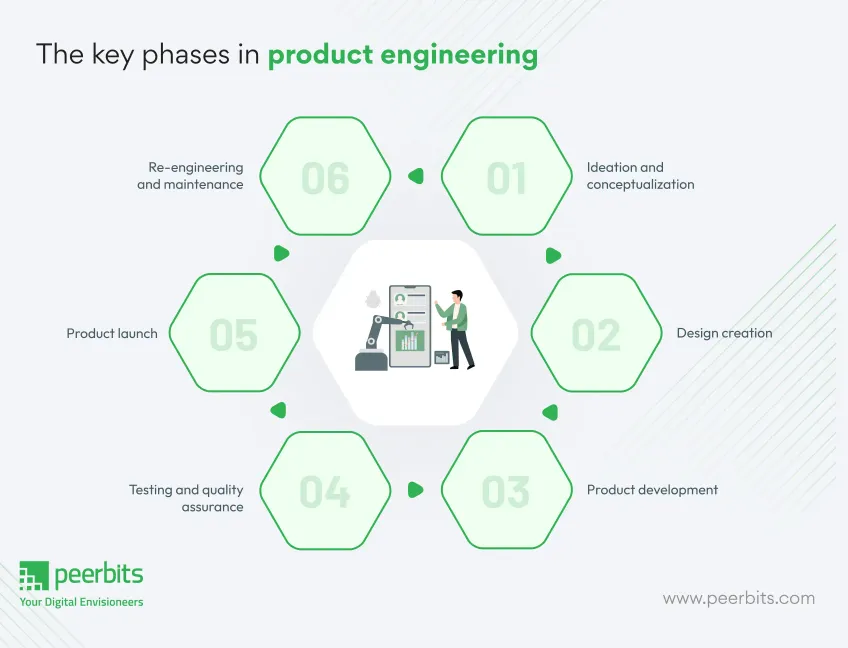
1. Ideation and conceptualization
The first step in the product engineering process involves gathering business requirements and identifying market needs. This stage focuses on understanding the core challenges, customer pain points, and business goals to shape the foundation of the product.
Through brainstorming and market research, the product vision begins to take shape, setting the direction for the entire project.
2. Design creation
Once the concept is clear, the design phase begins. This involves prototyping and refining user experience (UX) elements to create a product that is intuitive, functional, and meets user expectations.
Designers focus on the usability and interaction of the product, ensuring that the final solution is both visually appealing and easy to navigate.
3. Product development
During product development, agile methodologies or iterative processes are employed to build the product in manageable stages. These approaches enable teams to work efficiently, deliver incremental improvements, and incorporate user feedback regularly.
This results in a product that continuously evolves based on real-time insights.
4. Testing and quality assurance
Quality assurance is critical for ensuring that the product is robust, secure, and reliable. This phase includes rigorous testing to identify bugs, vulnerabilities, and potential failures.
Comprehensive testing ensures that the product meets quality standards, performs consistently, and is secure for end-users.

5. Product launch
The launch phase involves strategies to deploy the product smoothly and effectively. This includes preparing for a successful go-live by ensuring proper infrastructure, marketing, and customer support are in place.
A well-planned launch helps build momentum and ensures that the product reaches the intended audience without complications.
6. Re-engineering and maintenance
Once the product is launched, continuous maintenance and re-engineering are necessary to keep it relevant in a constantly changing market. This phase involves collecting feedback, addressing issues, and implementing new features or updates to improve functionality and performance.
Regular updates ensure the product remains competitive and meets evolving customer expectations.
Each of these phases in product engineering is essential for transforming an idea into a fully realized, market-ready product that can grow and adapt over time.
Benefits of product engineering services
- Enhanced innovation and scalability: Create adaptable solutions that grow with market demands.
- Faster time-to-market: Accelerate product development and stay ahead of competitors.
- Cost savings: Optimize processes to reduce costs and improve efficiency.
- Improved customer satisfaction: Deliver high-quality products that meet customer needs and expectations
- Enhanced innovation and scalability: Create adaptable solutions that grow with market demands.
- Faster time-to-market: Accelerate product development and stay ahead of competitors.
- Cost savings: Optimize processes to reduce costs and improve efficiency.
- Improved customer satisfaction: Deliver high-quality products that meet customer needs and expectations.
- Better risk management: Minimize potential issues through rigorous testing and proactive development.
- Increased product quality: Consistently develop products with superior performance, security, and reliability.
- Higher operational efficiency: Streamline business processes with customized solutions that improve workflow.
Choosing the right product engineering partner
Selecting the right partner for product engineering services is critical to the success of any product development journey. A reliable partner can help turn your ideas into reality with precision and efficiency.
Here are some key factors to consider when choosing a software development company.
Criteria for selecting a reliable software development company
- Proven track record: Look for companies with a history of delivering successful products and projects on time.
- Industry reputation: Check client testimonials, case studies, and reviews to gauge the company’s reliability and expertise.
- Alignment with business needs: Ensure the partner understands your business goals and is capable of tailoring solutions accordingly.
Questions businesses should ask potential partners
- What is your experience with similar projects or industries?
- Can you provide examples of products you've developed and their impact?
- How do you handle project timelines, budgets, and unexpected challenges?
- What is your process for maintaining product quality and security?
- How do you approach ongoing support and maintenance post-launch?
Importance of technical expertise and domain experience
The right product engineering partner should possess deep technical expertise and domain experience to develop a product that meets both functional and business requirements.
Their knowledge of modern technologies, development methodologies, and industry-specific challenges ensures that they can deliver solutions that are reliable, scalable, and future-proof.
Choosing the right product engineering partner can make all the difference in ensuring a product's success. Be thorough in evaluating potential companies and ensure they possess the technical skills, industry knowledge, and commitment to meet your unique business needs.
Conclusion
Product engineering services are important for building products that meet market demands, are efficient, and are scalable.
These services help businesses refine their ideas into practical solutions that drive growth, improve user satisfaction, and stay ahead of the competition.
For businesses aiming for sustainable success, adopting a structured product engineering approach will pave the way for steady improvement and competitive positioning.


